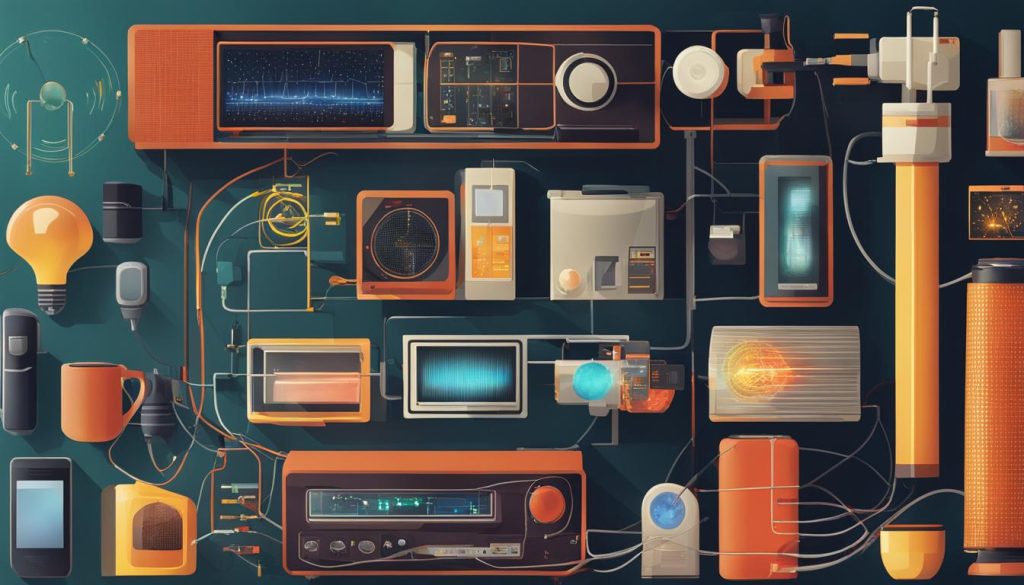As technology advances, we find ourselves surrounded by electronic devices and appliances that emit electromagnetic fields (EMFs). While many experts believe that low-frequency EMFs are not harmful, there are ongoing discussions about their potential health risks. In this article, I will delve into the different types of EMFs, their potential hazards, and the current research surrounding EMF radiation exposure.
Unravel EMF Radiation Dangers
- EMFs are waves of energy produced by electronic devices and appliances.
- There are two main types of EMFs: ionizing high-frequency EMFs and non-ionizing low- to mid-frequency EMFs.
- Long-term exposure to low-frequency EMFs may be linked to certain health conditions, but more research is needed.
- Potential health effects of EMF radiation include an increased risk of leukemia, brain cancer, and cognitive disorders.
- The sources of EMF radiation range from natural sources like the sun to man-made sources like power lines and wireless devices.
What are EMFs?
EMFs, or electromagnetic fields, are waves of energy that come from both natural and human-made sources. Natural sources of EMFs include the sun, while human-made sources include power lines, electrical appliances, and wireless devices like cellphones and Wi-Fi routers.
EMFs can be categorized into two main types: high-frequency EMFs and low- to mid-frequency EMFs. High-frequency EMFs are ionizing and have the potential to damage DNA and cells. On the other hand, low- to mid-frequency EMFs are non-ionizing and are widely believed to be harmless.
Non-ionizing EMFs include two subcategories: extremely low-frequency EMFs (ELF-EMFs) and radiofrequency EMFs (RF-EMFs). ELF-EMFs are generated by power lines, electrical wiring, and some appliances. RF-EMFs, on the other hand, are generated by wireless devices such as cellphones and Wi-Fi routers.
To give you a better understanding, here’s an image illustrating the different types of EMF exposure:

Potential Health Effects of EMF Radiation
The potential health effects of EMF radiation continue to be a subject of ongoing scientific research and debate. While numerous studies have not established a definitive link between EMF exposure and adverse health effects, there is evidence pointing to a potential risk associated with long-term, low-level exposure to EMFs.
Some studies suggest that exposure to EMF radiation may be associated with an increased risk of certain health conditions. Childhood leukemia, adult brain cancer, and cognitive disorders are among the conditions that have been investigated in relation to EMF radiation.
Furthermore, individuals exposed to EMFs have reported various symptoms that they attribute to such exposure. These symptoms include headaches, tremors, dizziness, memory loss, and sleep disturbances.
However, it is important to note that the existing body of research is inconclusive, and more comprehensive studies are needed to determine the true extent of these potential health risks.

Overall, the potential health effects of EMF radiation remain a topic of scientific interest and concern. While further research is necessary to fully understand the risks, it is recommended to stay informed and take proactive measures to minimize exposure to EMF radiation.
Sources of EMF Radiation
EMF radiation, or electromagnetic field radiation, can originate from various sources, including both natural and human-made factors. Understanding the different sources of EMF radiation is crucial in recognizing potential exposure risks and taking appropriate precautions.
Natural Sources
The sun and the Earth’s magnetic field are among the primary natural sources of EMF radiation. The sun emits a wide range of electromagnetic waves, including visible light, ultraviolet (UV) radiation, and higher-energy ionizing radiation, such as X-rays and gamma rays. While exposure to low levels of these natural EMFs is generally safe, excessive or prolonged exposure to ionizing radiation can be harmful to human health.
Human-Made Sources
Human-made sources of EMF radiation are prevalent in modern society and can be found in everyday environments. These sources include:
- Power lines: The electricity transmission and distribution network, including power lines, transformers, and substations, produces low-frequency EMF radiation.
- Electrical appliances: Household appliances like refrigerators, televisions, hairdryers, and microwaves generate low-frequency EMFs.
- Wireless devices: Mobile phones, Wi-Fi routers, Bluetooth devices, and other wireless technologies emit radiofrequency electromagnetic radiation, which is a form of non-ionizing radiation.
- Medical equipment: X-ray machines, computed tomography (CT) scanners, magnetic resonance imaging (MRI) machines, and radiation therapy equipment produce both non-ionizing and ionizing radiation, depending on the type of device.
It is important to note that different sources of EMF radiation emit different types of radiation. Non-ionizing radiation is typically emitted by devices like microwave ovens, cellphones, and Wi-Fi routers. On the other hand, ionizing radiation is emitted by X-ray machines, gamma cameras, and certain medical procedures involving radioactive materials. Understanding the distinction between ionizing and non-ionizing radiation is crucial in evaluating potential health risks associated with EMF exposure.
By being aware of the various sources of EMF radiation, individuals can make informed decisions to minimize their exposure and prioritize their well-being.
Research on EMF Radiation Harmfulness
The potential harmfulness of EMF radiation is an ongoing topic of research and investigation. Numerous studies have examined the link between EMF exposure and the risk of cancer, particularly brain cancer. While some studies have found a possible connection, it is important to note that other studies have not established a definitive link between EMF radiation and cancer.
The International Agency for Research on Cancer (IARC) has categorized non-ionizing EMFs in the radiofrequency range as a possible human carcinogen, indicating the need for more research in this area. Additionally, there have been suggestions of potential links between EMF exposure and neurological disorders, such as Alzheimer’s disease.
However, it is crucial to acknowledge that more research is required to fully understand the potential health risks associated with EMF radiation. Ongoing studies are essential to evaluate the safety concerns and determine the true extent of the impact that EMF radiation may have on our health and well-being.
By conducting comprehensive and rigorous research, we can gain further insights into the effects of EMF radiation on our bodies. This knowledge will enable us to develop comprehensive safety guidelines and make informed decisions regarding our exposure to EMF radiation.
Conclusion
Understanding the potential health risks of EMF radiation is crucial in order to protect ourselves. While most research indicates that low-frequency EMFs are not harmful, some studies have suggested possible associations with certain health conditions. To minimize these potential risks, there are practical precautions that individuals can take.
Reducing EMF exposure is one of the key steps in safeguarding against potential harm. This can be done by limiting the use of wireless devices, especially during sleep, and keeping them at a safe distance when in use. Additionally, choosing wired connections over wireless whenever possible can help reduce overall exposure.
Another important aspect is practicing safe usage of electronic devices. This includes using devices in well-ventilated spaces, avoiding prolonged contact with the body, and taking breaks from device use to reduce continuous exposure. Education and awareness about EMF radiation safety are also vital for ensuring long-term protection.
While more research is needed to fully understand the long-term effects of EMF radiation, individuals can prioritize their health by staying informed and implementing proactive measures. By adopting these simple strategies, we can safeguard ourselves against potential risks and promote EMF radiation safety in our everyday lives.
FAQ
What are the potential health risks of EMF radiation?
While most researchers believe that low-frequency EMFs are not dangerous, some scientists question their safety and call for more research. There is evidence suggesting that long-term exposure to low-frequency EMFs may be linked to an increased risk of certain health conditions, including leukemia and cognitive disorders.
What are EMFs and where do they come from?
EMFs, or electromagnetic fields, are waves of energy that come from both natural and human-made sources. Natural sources include the sun, while human-made sources include power lines, electrical appliances, and wireless devices like cellphones and Wi-Fi routers.
What are the potential health effects of EMF radiation?
The potential health effects of EMF radiation are a topic of ongoing scientific research and debate. While most studies have not found a definitive link between EMF exposure and adverse health effects, there is some evidence to suggest that long-term, low-level exposure to EMFs may be associated with an increased risk of certain health conditions, including childhood leukemia, adult brain cancer, and cognitive disorders.
What are the sources of EMF radiation?
EMF radiation can come from a variety of sources, both natural and human-made. Natural sources include the sun and the earth’s magnetic field, while human-made sources include power lines, electrical appliances, wireless devices, and medical equipment such as X-ray machines and MRI scanners.
What does the research say about the harmfulness of EMF radiation?
The research on the potential harmfulness of EMF radiation is a topic of ongoing investigation. While some studies have found a possible link between EMF exposure and an increased risk of cancer, particularly brain cancer, other studies have not found a definitive connection. The International Agency for Research on Cancer (IARC) has classified non-ionizing EMFs in the radiofrequency range as a possible human carcinogen, highlighting the need for further research.
How can I protect myself from EMF radiation?
To minimize potential risks, individuals can take practical precautions such as reducing EMF exposure, using devices at a safe distance, and limiting the use of wireless devices. More research is needed to fully understand the long-term effects of EMF radiation and to develop comprehensive safety guidelines.




